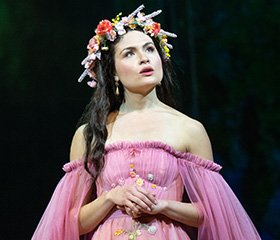The cast and crew of Camelot are heading into the final weeks of a six-month stretch of rehearsal and performance. Phillipa Soo, meanwhile, who plays Guenevere, is heading into the final weeks of a fourteen-month stretch in which she has lent her actorly gifts and lovely voice to high-profile productions including Into the Woods (Broadway), Guys and Dolls (Kennedy Center), and Camelot. How does the current show sit amidst this activity?
“It’s the hardest thing I’ve ever had to do,” she replied the other day in her dressing room. “It’s extremely demanding in terms of the stamina and the storytelling. It’s the first time I’m doing a heavy lift in terms of the scene work.”
By scene work Soo means not only Camelot’s familiar tunes but its less familiar spoken words. “Many people who came to this show knew some of the songs,” Soo said, “but they probably didn’t realize how much dialogue there is, both in the original version and in our version, by Aaron Sorkin. When I first read his script, I was immediately taken with this story about people trying to navigate the darkness and chaos of the world and to find some good somewhere.” She added: “Aaron’s dialogue rides the line between the dramatic and the comedic, so there’s an inner awareness you have to bring to it. You can’t just show up and let it carry you. As an actor, you are the tempo. You establish how fast things go.”
Soo contrasted this aspect of Camelot with Hamilton, of which she was a luminous original cast member. “With Hamilton, the tempos were set. We were on a click. If I felt really tired on a particular day, the click would feel fast; if I felt energized, the click would feel slow. But the click was the click and it never changed.”
With Camelot, Soo went on, “you have to be hyper- aware of your responsibility for maintaining the tempo. It doesn’t matter if it’s 90 degrees outside, and you show up at the theater tired. You still have to maintain that tempo. Otherwise, it doesn’t fly.”
What about the physical demands of Camelot? “We’re on a raked stage, wearing heavy costumes, so that takes it out of you. Plus I’m constantly on the go. I don’t really get a chance to sit down until intermission.”
Camelot has required rigor not just by its innate demands but by where it has fallen in terms of Soo’s career. “When I started this work a decade ago, I used to be able to go all day and show up to do a performance at night without a problem. That’s not really the case anymore. I now have a strict health and wellness routine.”
The run of Camelot has had many compensations. “I think it’s meant so much to people in part because we’re in a challenging time for the theater,” Soo said. “People were already used to staying at home and letting streaming content rule their lives. But with the pandemic that process accelerated.” It is, she added, “harder to be in an audience these days. We’re asking people to put themselves in a place where they have to think deeper when they come here than they would in their normal lives. It’s a huge ask.”
I mention that whereas people used to get their in-person experience from religion now they get it primarily from live performance. “That’s true,” responded Soo, “but theater in at least one crucial sense is different than church. Because with religion you’re gathering with people who share your basic beliefs. That’s part of the comfort. In the theater, you may be surrounded by people who aren’t of like minds. Where else does that kind of communal experience happen? It’s extraordinary and we need to find ways to nourish it.”
Since the run of Camelot is winding down, Soo was eager to extend her gratitude to the people who have surrounded her these past six months. “Every day, I have felt the love and enthusiasm in the cast and from our director, Bart [Sher]. And from the audiences at the stage door. They have been phenomenal.” She added: “I’m not sure what’s next for me professionally. But I’m sure I’ll be feeding off the good Camelot vibes for a while.”
Brendan Lemon is a freelance journalist in New York.
